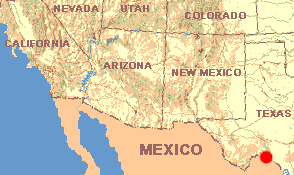 February 7, 1988
February 7, 1988TEXAS: Valverde County
US 377 North Campground in Amistad National Recreation Area 7 miles north of Del Rio
 February 7, 1988
February 7, 1988If this morning for three hours you could have tolerated the 35º, wet, quarrelsome wind and walked with me through the cenizo uplands and along Amistad's shore, here are the birds you'd have seen:
Despite the cold wind, this is a pretty good list! About a third of the species, those in blue letters, seldom or never are found east of the Mississippi River, so to an Easterner like myself, they're good sightings. Over a third of the species seen today are just overwintering at Amistad.
Probably the Cinnamon Teal was the day's highlight, because I've not seen one since I arrived here a month ago. It accompanied three Northern Shovelers floating in a small inlet. Its small size was a good fieldmark, as was its ruddy color. I double-checked this identification because my field guides' distribution maps indicate that in the winter Cinnamon Teal are not supposed to range this far east in Texas.The largest bird was the Great Blue Heron, with a wingspread of about six feet. Maybe the prettiest was the Yellow-headed Blackbird, the male of which looks like a blackbird with its body's front third dipped in yellow paint, and its shoulders daubed with white. The female shows less yellow and is brownish instead of black. Certainly the brightest bird was the Cardinal, which seems just as common here as in the East.
The day's most dramatic observation was made right beside Henry as I was returning from the walk. Each morning several campers toss onto the gravel parking area handfuls of grain for the hoards of blackbirds hanging out in the Seep-willow thicket surrounding camp, singing loudly and almost constantly from dawn to dusk. These flocks are remarkably integrated. About half are Red-winged Blackbirds, about a quarter are Great-tailed Grackles, and a quarter are Brown-headed Cowbirds. Usually four or five Brewer's Blackbirds also are present. When this flock swarms into the parking area and begins feeding, sometimes several hundred House Sparrows wing in out of nowhere to join them. On about every third day the single Yellow-headed Blackbird spotted today appears among them. When this immense flock is settled in the parking area with its thousands of members quarreling among themselves, fluttering wings, singing... it's spectacular. And when a camper door swings open or a dog walks by, causing the whole multitude to rise up en masse, it's breathtaking! I've had to string a tarp above my tent to protect it from droppings...
Also found during today's walk was the rear half of a Whitethroat Woodrat -- one of the fabled "packrats" or "traderats" that in TV westerns always steal old cowpokes' gold watches, leaving acorns in return. With white belly and feet, and rusty-gray upper body, packrats are readily distinguishable from common house rats, or Norway rats, because their habits are different, and house rats bear scaly, not hairy tails, as do packrats. Not far from today's half of a rat rose a typical packrat home, consisting of a large jumble of woody seep-willow sticks and dry horse-turds practically burying a much branched, spreading, two-foot tall Nopal cactus. Why this particular packrat was only half there, I haven't a clue. Owl, fox... ? It'd been cut in half as neatly as if with a packrat-guillotine.